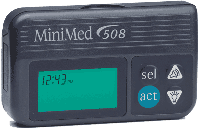This page as a pdf file
My pump
How Diana Maynard came to use an insulin pump
This article has also appeared in the Scottish Nurse magazine, and is reproduced here with permission.
Introduction
MiniMed 508 insulin pump with remote control


There is no doubt that the insulin infusion pump has changed my life. Not only has my diabetes control improved considerably, but my emotional and physical state has also vastly improved. My HbA1C is currently at 6.7, whereas 2 years ago it was over 10, and about 5 years ago it was in the teens. I feel full of life - my energy levels have increased, my mood has altered and my outlook on life has once again become positive.
A small black box
All this due to a small black box the size of a pager? It sounds too good to be true, like one of those advertisements for vitamin supplements or weight loss methods you find in magazines! And yet almost everyone I know who uses a pump has a similar attitude. Although in countries such as the USA and Germany, CSII (continuous subcutaneous insulin infusion) pumps, or insulin pumps as they are more usually known, are fast becoming the treatment of choice, in the UK, less than 1% of the diabetic population uses them, and most have to fund it themselves.
Unable to maintain stable blood sugar levels
I was diagnosed with Type 1 diabetes in 1980, at the age of 8, and gradually progressed from one injection a day to an MDI regime. In about 1998 I started to develop background retinopathy, and despite extensive laser treatment, it had progressed to the proliferative stage by 1999. I was registered first partially sighted, and later, blind. Despite a lot of effort, I was unable to maintain stable blood sugar levels, and I grew more and more desperate for a means of control if I was to prevent my complications getting any worse. After much investigation and research, I decided that I had nothing to lose by giving a pump a try. To my surprise, my doctor was very supportive, and the clinic even agreed to pay the cost of the consumables, although not the cost of the pump itself. I finally got "hooked up" at the beginning of April 1999, and although there have been some minor mishaps along the way, I haven't looked back since.
Increased flexibility
The thing I love most about the pump is not the freedom from injections, as one might expect, but the increased flexibility it gives me. I'd been giving myself 4 or 5 injections a day for years, and with the new insulin pens and very fine needles, it was no trouble at all. I could inject at the table in a restaurant and noone would even notice. But I never got used to the rigidity that diabetes imposed on me - the fact that I couldn't do things spontaneously, like play a game of tennis, stay away overnight unexpectedly, or eat at an unusual time. With the pump, I can eat what I want when I want, I don't have to get up at a certain time in the morning to take my insulin, I can be more spontaneous about exercise - in short, I can be "normal". Not only does this make my life generally easier, it has a huge psychological impact on how I perceive myself and my condition.
Attached to something 24 hours a day
Photo of Diana Maynard
Many people have reservations about the thought of being attached to something 24 hours a day, seven days a week. For me this was never really an issue, although it did feel a little strange at first. But you can't feel the infusion set at all, unless there's a problem with it, and besides, knowing the pump is there is something I find reassuring.
I did have problems with how I was going to wear the pump though. Although it is small (about the size of a pack of cards) it's nott always easy to find a place to put it, especially if you're not wearing clothes with pockets. At first I wore jeans a lot, and attached it to my belt or waistband with the clip that comes with it. Being a ballroom dancer, and keen on a variety of sports, it was sometimes tricky to find a way to wear it. With the help of other pump users, some ready-made pump accessories, and a bit of ingenuity, I started coming up with some solutions. Even with a skimpy dance costume, I have successfully managed to wear the pump and dance without anyone noticing it, or it falling off!
Responsibility
Wearing a pump does bring with it some responsibility. Because you only use short-acting insulin (in my case, Humalog), if for some reason the insulin supply is cut off, you can go into DKA in a matter of hours. So you have to be vigilant, and do regular blood tests. This wasn't a problem for me, since I was doing between 5-10 tests a day anyway. If my blood sugar level does rise, I can correct it very quickly with an extra bolus. Or if I suspect there is a problem with the pump or infusion set, I take the insulin by syringe until I've solved the problem.
Perceived lack of support
One of the major hurdles to the use of pumps in this country is the perceived lack of support available. Many medical professionals have little or no knowledge of pumps and are therefore reluctant to promote pump therapy to their patients. There are, however, valuable support mechanisms available in the UK. The pump companies offer training and backup support; some hospitals have now set up "centres of excellence for pump therapy"; there are some very good books on the market; there are a handful of local pump groups, both for patients and medical professionals; and there is a website and associated discussion group at http://www.insulin-pumpers.org.uk, which I help to administer.
Conclusion
What more can I say? Pump therapy has changed my life, and in spite of occasional inconveniences that it causes, you would have to wrestle it off my dead body to get me to give it up and go back to injections.
Created: September 2001; Last updated: Saturday 26 January 2002
Other pages about pumps
[ Funding issues | Pros and cons of pumping | Diabetes UK on pump therapy | Pumps in the Republic of Ireland | What is an insulin pump? | Just like wearing a yoyo | Not controlled, but in control! | Rewriting the diabetes rulebook | To pump or not to pump? | Pumps in pregnancy | Using the insulin pump during pregnancy | Life on a pump | UK pump news | Which pump? | MiniMed | Disetronic | Animas | Books to help with diabetes | Other pump websites | My pump ]
Reader comments
-
On 11 May 2002 M N Durocher wrote:
I have been diabetic for almost 20 years now, and have had problems keeping my blood sugar balanced. My doctor says I am a brittle diabetic. I have taken 2 injections a day for the duration but my doctor quite a while back suggested I go to 4 or 5 injections. I refused because I had a hard time with injections. Now I am reading about these insulin pumps and think that I would be a good candidate for one. I am seeing my doctor next week and will ask her about the pump. I feel as though for the first time there is hope for me to improve my control. I have had vitrectomies in both eyes because of retinopathy and my feet and legs are plagued with neuropathy which I need to take alot of medications for. It'd be great if I could improve on my BG levels and perhaps improve in my feet and legs.
-
On 7 Mar 2002 George Scrushy wrote:
I have been diabetic for 27 of my last 41 years. I maintained reasonable control of my blood sugars but developed proliferative retinopathy in my right eye 2 years ago. I received successful laser therapy. I changed doctors and began to see a diabetic specialist. He recommended insulin pump therapy. I began using a Disetronic D-Tron pump in January 2001. I have since regained much feeling in my hands and feet and taken control of my life. I can now sleep as late as I like and eat when I want to and as much or as little as I want to. My HbA1c has fallen from 10.8 to 5.9. I would recommend pump therapy to anyone wanting to regain control of their life and win the battle over diabetes.
-
On 5 Dec 2001 Sheila L Mynatt wrote:
You mention in your article that there was not a lot of support or information in the UK for pump users. Well, I live in the states and my husband has been a diabetic for 15 years and has been on the pump for 2 years and we still have trouble getting or finding new information. I have a diabetic child in my Sunday school class that is 10 years old and has been diabetic for 5 years and until I gave her mother information on the pump she had never heard of it. Unless you look for information it is hard to find, and I just don't understand why. The pump has helped us so much. I think that doctors are afraid of the control that it gives people and the insurance companies don't like the cost.

